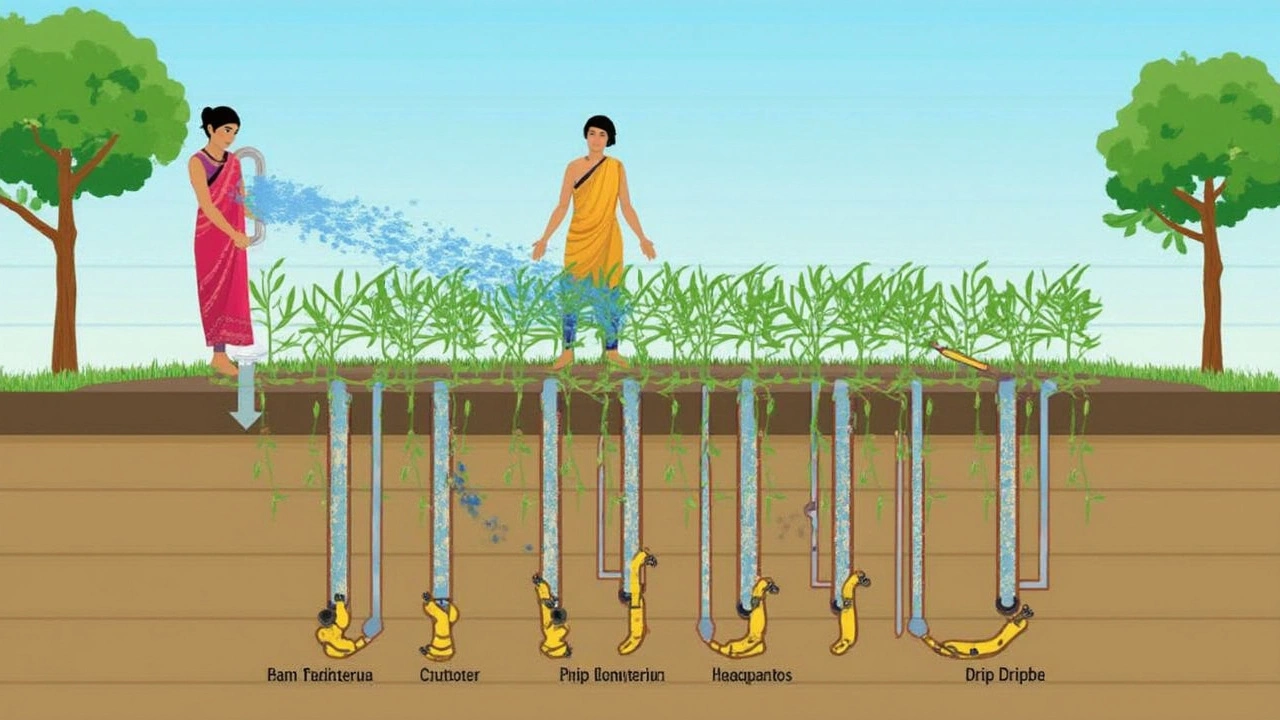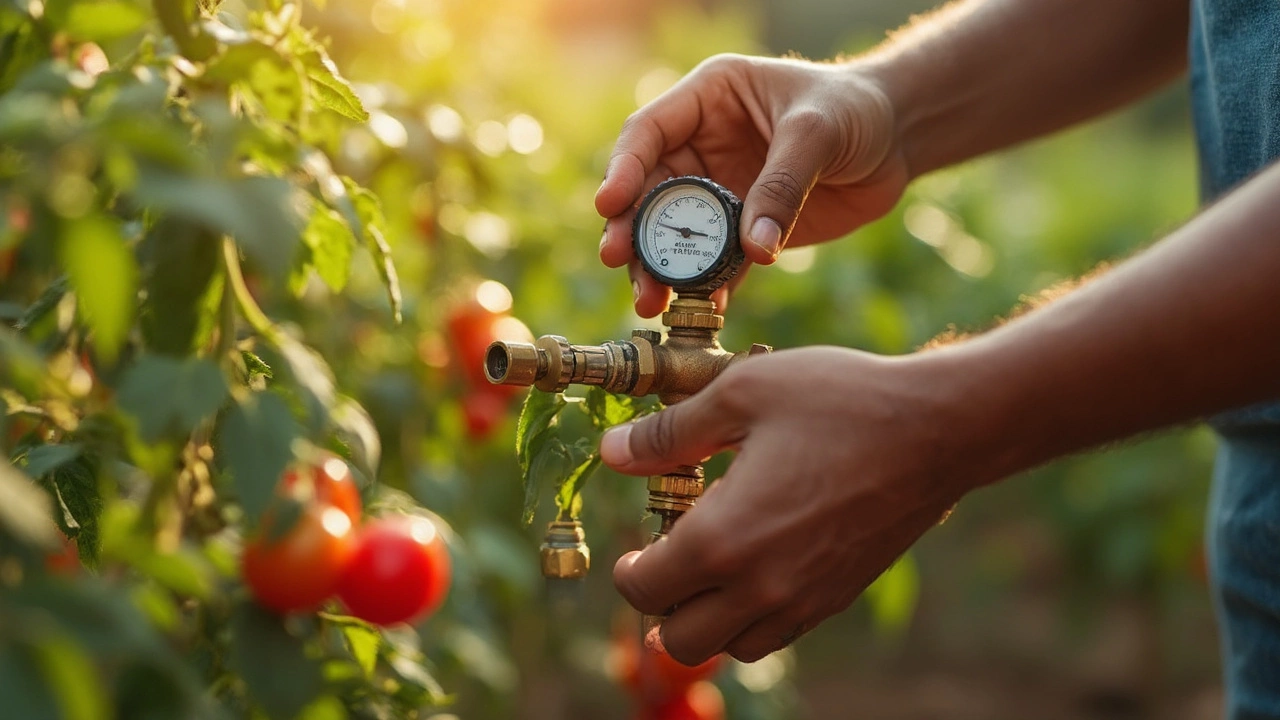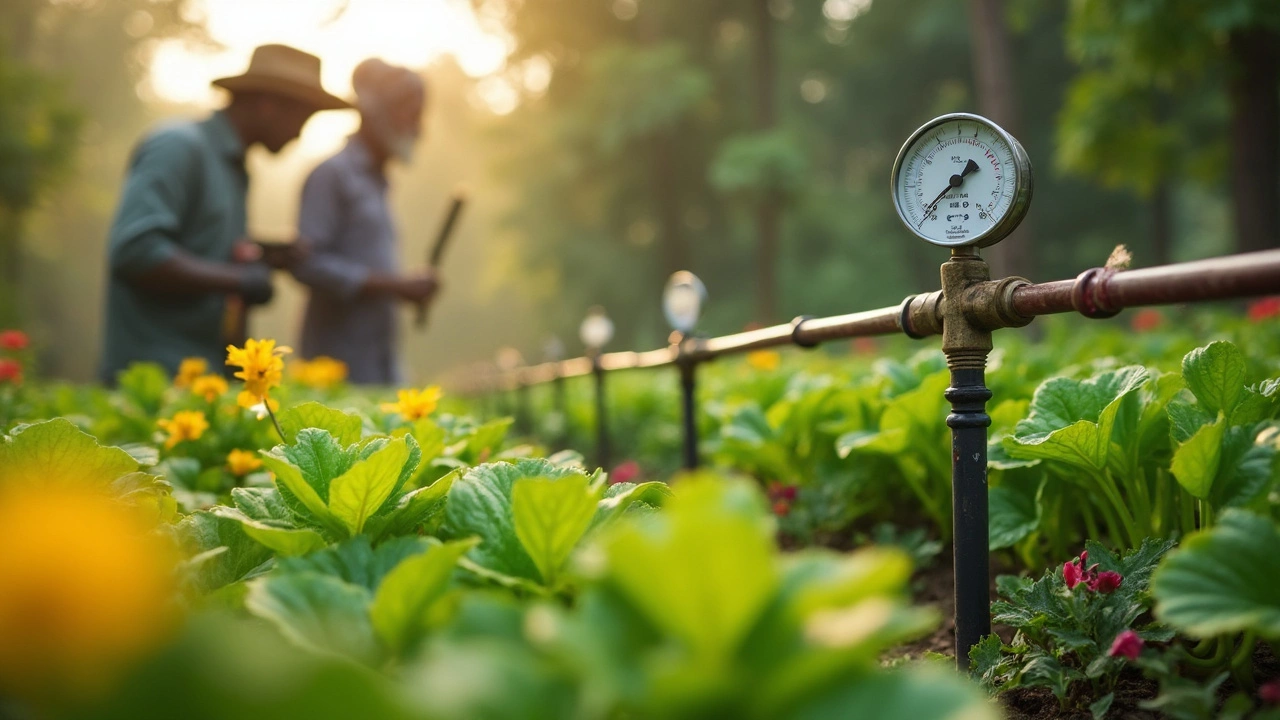If you’re wrestling with hoses and drip lines in your backyard, you’ve probably heard people talking about PSI. But is 30 PSI too much for drip irrigation, or are you safe to crank it up and walk away? Let’s break it down.
PSI just means pounds per square inch—it’s a fancy way of measuring how hard water pushes through your system. Too much, and things can go haywire: fittings pop off, emitters spray the neighbor’s cat, or lines leak all over the place. Too little, and your plants are left dry and unhappy. Honestly, the right pressure makes all the difference between a thriving garden and a patchy mess.
Most drip systems are made to work best at pretty low pressures, but here’s the catch: not all setups and emitters are created equal. If you don’t know your system’s sweet spot, you’re kind of flying blind. The good news? Discovering your system’s ideal PSI isn’t rocket science. With a simple pressure gauge and a little patience, you’ll see pretty quickly what works and what doesn’t.
- What's PSI and Why Does It Matter?
- Typical Pressure Needs for Drip Systems
- What Happens at 30 PSI?
- Signs Your System Isn't Happy
- Simple Ways to Fix Pressure Problems
What's PSI and Why Does It Matter?
PSI stands for pounds per square inch, which is just a way of measuring water pressure. When we talk about drip irrigation, PSI tells you how strongly water is being pushed through your tubing and emitters. It’s kind of like tire pressure—too much or too little isn’t good, and there’s a sweet spot where everything runs right.
If your system has too much pressure, you’ll notice drip emitters spitting water everywhere, little leaks popping up, or even tubing connections blowing apart. Too little pressure, on the other hand, means you might see weak dribbles or some plants not getting any water at all—especially those farthest from the water source.
Most drip irrigation parts, like emitters and micro-tubing, are designed for low pressure. You’ll usually see ratings like 15 PSI or 20 PSI printed right on the packaging. Going above these, even by a bit, can wear parts out faster or mess up your watering patterns. If you’re guessing at the pressure or just using what comes out of the faucet, you could be asking for trouble.
Want to know what your water pressure actually is? Grab a cheap screw-on pressure gauge at any hardware store. Just hook it up to your spigot before the drip line. It’ll save you a ton of guesswork and can help you spot problems before they get out of hand.
Typical Pressure Needs for Drip Systems
Here’s the deal with pressure in your drip system: most gear on the market is meant to run at pretty low psi. If you crank it up, you’ll end up replacing blown-out drip emitters or leaky fittings. Most of the stuff people buy at hardware stores expects somewhere between 10 and 25 psi, with the sweet spot for dependable performance landing right around 20 psi. That’s not an accident. Most commercial emitters and tubing are built for pressure in that range.
By the way, your home’s outdoor faucet probably pumps out water at 40-60 psi, sometimes even higher. That’s great for a sprinkler, but it’ll wreck standard drip lines in no time. You almost always need a pressure regulator when you install a drip setup. Without one, you’re playing drip system roulette.
| Component Type | Recommended PSI Range |
|---|---|
| Standard Drip Emitters | 10 - 20 psi |
| Micro-sprayers / In-line Drip Tubing | 15 - 25 psi |
| Soaker Hose (Porous Pipe) | 8 - 15 psi |
| Home Garden Outdoor Spigot | 40 - 65 psi |
If you see a package that says “pressure-compensating emitters,” that means they can handle a bit higher range and still give every plant a similar drink. Even then, going above 30 psi usually isn’t a good idea for any drip setup meant for gardens or raised beds.
Why such low pressure? At higher push, drip emitters turn into little fountains, which defeats the whole point of slow, targeted watering. Keeping pressure around 20 psi lets the system do its job—delivering water directly to roots without wastage, run-off, or broken parts. If you’re piecing things together from scratch, double-check that everything—from the main tubing down to the smallest emitter—fits the right range. Believe it or not, mismatched parts make leaks and clogs way more likely. Your keyword here: drip irrigation.

What Happens at 30 PSI?
Alright, so the pressure gauge on your drip irrigation reads 30 PSI. Is that good, bad, or somewhere in between? Here’s what actually happens when your system is running at this level.
Most drip irrigation gear—especially the typical 1/4-inch tubing and standard emitters—are rated for a sweet spot around 20 PSI. Some beefier setups can handle a bit more, but 30 PSI starts pushing the limits. It's a bit like running your washing machine at full blast all the time—sure, it works for a while, but stuff wears out faster.
If you run your system consistently at 30 PSI:
- Fittings and connections are more likely to leak or even blow apart, especially if they're cheap or not tightened properly.
- Emitters may let out water faster than they’re meant to, leading to uneven watering and wasted water.
- The pressure can sometimes burst thinner tubing—especially those thin spaghetti lines used for small plants or pots.
This isn’t just theory. A test by the University of Arizona Extension showed that standard drip emitters designed for 1 gallon per hour (GPH) could push out 1.3 to 1.8 GPH at 30 PSI instead of the intended rate. That’s a 30% to 80% increase—enough to drown some plants and starve others further down the line.
| Component | Recommended Pressure | What Happens at 30 PSI |
|---|---|---|
| Standard Emitter (1/4" tubing) | 15-20 PSI | Over-watering, leaks possible |
| Mainline Tubing (1/2" or more) | Up to 30 PSI | Usually safe, but watch for weak joints |
| Pressure Compensating Emitters | 10-50 PSI | Works as intended |
Now, if you have pressure-compensating emitters, you get a bit of a free pass—those handle higher pressure without messing up flow rates. But these are usually marked and a bit pricier. For the usual non-compensating stuff you find at garden centers, 30 PSI starts pushing the envelope.
So, if you want your drip irrigation system to have a long, leak-free life, play it safe and stick closer to the recommended range for your gear. Not sure what yours can handle? Check the packaging or give it a quick search. Your garden (and your wallet) will thank you.
Signs Your System Isn't Happy
When your drip irrigation is out of whack, your garden gives you clues. Ignore them, and you risk wasting water, money, or even your plants. Most problems with drip irrigation come down to pressure. Here’s how to spot trouble before it snowballs.
- Leaky Connections: If you see water spraying from joiners or valves, your pressure’s probably too high. Drip pieces are usually snapped or pushed together; too much force can literally pop them apart.
- Blown or Popped Emitters: Emitters that shoot water like little fountains instead of gentle drips? Classic sign your PSI is through the roof. Most drip emitters, especially the basic 1-2 gallon-per-hour types, are made for 15-20 psi. At 30 psi, they might blow right out of the tubing.
- Uneven Watering: Some areas soaked, others bone dry? Pressure that’s too high or too low causes this. High pressure can slam the first few emitters with water, but starve the last ones on the line.
- Dripping at Off Times: If you shut the system off and water keeps leaking or seeping from the lines, pressure has stressed your fittings and they’re not sealing anymore.
Want a quick comparison? Check out what often goes wrong at different pressure levels:
| PSI Level | Common Problems | Results in Garden |
|---|---|---|
| Below 10 PSI | Emitters barely drip, water doesn't reach far lines | Plants at the end suffer |
| 15-20 PSI | Optimal for standard emitters | Even watering, happy plants |
| 30 PSI | Possible bursts, leaky fittings, blown emitters | Leaks, uneven watering, system breakdowns |
| 40+ PSI | Major breaks, tubing splits, fittings fail fast | Big water loss, major repairs needed |
If your water bill spikes or your garden suddenly starts looking ragged, don’t blame it on the weather—check your system. And remember, you don’t need fancy sensors. Sometimes, just a five-minute walk around the garden is enough to catch leaks, listen for weird hissing sounds, and see if plants are drying out or water is gushing where it shouldn’t. Solving these early keeps repairs simple and backyard drama to a minimum.

Simple Ways to Fix Pressure Problems
Running into drip irrigation pressure problems isn’t just frustrating—it can waste water, money, and your time. Good news: you don’t need to call in a pro to sort it out. Most fixes are cheap, fast, and don’t require special tools. Let’s get right into what actually works.
First, it all starts with knowing your numbers. You can pick up a basic pressure gauge at most hardware stores. Just screw it onto a faucet and see what you’re dealing with. If the reading is sitting at 30 psi or higher, and your system is giving you trouble, it’s worth dialing it back.
“Drip systems work best around 15 to 25 psi. Any higher, and you risk blown fittings or uneven water flow,” says the team at Rain Bird, a major irrigation supplier.
So what’s next when you find the pressure is too high?
- Add a pressure regulator: These handy devices drop the pressure right where you want it. They come in different ratings—12, 20, or 25 psi are the most common. Screw it on before your filter for best results.
- Check your lines and emitters: Sometimes leaks or blockages mess with the pressure. Walk your lines, look for pinhole leaks, or clogged emitters, and swap out any duds.
- Split the zones: If you’ve got too many emitters on one line, pressure drops fast at the far end. Try breaking your garden into two or more zones and run each on its own timer.
- Avoid running your drip off a high-pressure hose direct: Your home’s outdoor water supply might be much higher than what your drip system needs. Always regulate first, don’t trust luck.
- Flush your system: At least twice a season, let water run straight through the lines with the end caps off. This clears buildup and keeps things running smooth.
Just to give you an idea of what’s normal, here’s a quick chart that breaks down the sweet spot for common drip emitters and accessories:
| Component | Optimum Pressure (psi) |
|---|---|
| Standard drip emitters | 15–25 |
| Micro-sprays | 20–30 |
| Soaker hoses | 10–12 |
| Mainline tubing | Up to 30 (with regulator) |
If you tackle the big issues—regulate, check for leaks, split zones, and do some seasonal cleaning—your system will thank you with fewer hassles and healthier plants. Not sure which regulator or fix is right for you? Most stores have a garden section rep who’s been there, done that. Don’t be afraid to ask, or just look for brands like Toro, Rain Bird, or DIG. They know their stuff.

